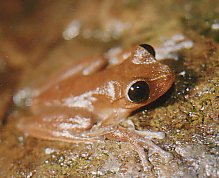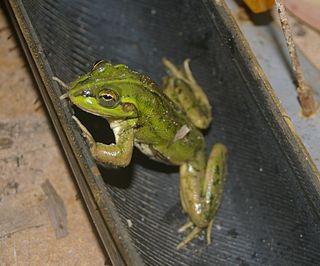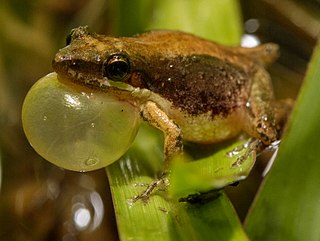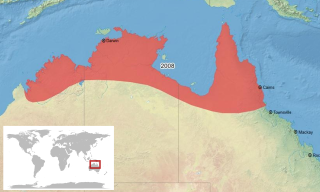
Litoria is a genus of hylid tree frogs, sometimes collectively referred to as Australasian treefrogs.

The Australian lace-lid is a species of tree frog in the subfamily Pelodryadinae. It is endemic to the wet tropics of north-eastern Queensland, Australia.

The desert tree frog, or little red tree frog, is a species of tree frog native to Australia, southern New Guinea, and Timor. It is one of Australia's most widely distributed frogs, inhabiting northern Australia, including desert regions and much of temperate eastern Australia. It is one of the few Australian tree frogs to inhabit arid, tropical, and temperate climates.

The orange-thighed frog is a species of tree frog native to a small area of tropical northern Queensland, Australia. It is a green frog with distinctly orange eyes, and is very similar in appearance to the red-eyed tree frog.

The wallum sedge frog, also known as the Olongburra frog or the sharp-snouted reed frog, is a species of frog that is endemic to Australia. Varying in color from brown to dark green it inhabits the thick and often acidic marshes of the Wallum along the coast of Queensland and New South Wales. Mating season comes in early spring, often after heavy rainfalls. Females attach their eggs to grasses and sedges. Their call is high pitched and follows a "creeeek... crik" pattern.
Ranoidea vagitus, the wailing frog, is a species of tree frog occupying the arid and monsoonal Kimberley region. It is a ground dweller, which evades dry periods by burrowing and hibernating - emerging to breed during floods.

Ranoidea platycephala, commonly known as the water-holding frog, is a species of frog common to most Australian states. It differs from most other members of the subfamily Pelodryadinae as a ground dweller and the ability to aestivate. It can live for five years without drinking.
The small frog is a species of frog in the subfamily Pelodryadinae. It is endemic to Australia, where its natural habitats are subtropical or tropical dry lowland grassland and intermittent freshwater marshes.
The Cape Melville tree frog is a species of frog in the subfamily Pelodryadinae. It is endemic to Australia, and has been found only in Queensland, in Cape Melville National Park. Its natural habitats are subtropical or tropical moist lowland forests and rivers.

Dahl's aquatic frog is a species of frog in the subfamily Pelodryadinae, endemic to Australia. Its natural habitats are dry savanna, subtropical or tropical dry lowland grassland, freshwater lakes, intermittent freshwater lakes, freshwater marshes, and intermittent freshwater marshes.

Davies' tree frog is a species of frog in the subfamily Pelodryadinae. It is endemic to Australia. Its natural habitats are subtropical or tropical dry forests, subtropical or tropical moist lowland forests, subtropical or tropical dry shrubland, and rivers. It is currently threatened by habitat loss.
The buzzing tree frog is a species of frog in the subfamily Pelodryadinae. It is endemic to Australia. Its natural habitats are temperate forests, subtropical or tropical swamps, swamps, intermittent freshwater lakes, intermittent freshwater marshes, and urban areas.
The fringed tree frog is a species of frog in the subfamily Pelodryadinae. It is found in Australia and New Guinea. Its natural habitats are subtropical or tropical moist lowland forests, subtropical or tropical moist montane forests, rivers, intermittent rivers, rural gardens, and heavily degraded former forest.

The green-eyed treefrog is a species of Australasian treefrog in the subfamily Pelodryadinae that occurs in the Wet Tropics of Australia.

The bumpy rocket frog, also known as Peters' frog, is a species of frog in the subfamily Pelodryadinae. It is abundant and endemic to Australia, where it is found from northern Australia south to Maryborough, Queensland.

The javelin frog is a species of frog in the subfamily Pelodryadinae, that is endemic to Australia. Its natural habitats are subtropical or tropical dry lowland grassland, swamps, and intermittent freshwater marshes.

The bridled frog is a species of frog in the subfamily Pelodryadinae. It is found in Australia and New Guinea. Its natural habitats are subtropical or tropical dry forests, moist savanna, intermittent rivers, swamps, intermittent freshwater marshes, and ponds. It is threatened by habitat loss.

The pale frog is a species of frog in the subfamily Pelodryadinae, endemic to Australia. Its natural habitats are subtropical or tropical dry forests, subtropical or tropical seasonally wet or flooded lowland grassland, and intermittent freshwater marshes.

The Wotjulum frog is a species of frog in the subfamily Pelodryadinae. Its habitats are subtropical or tropical dry forests, subtropical or tropical moist lowland forests, subtropical or tropical swamps, rivers, intermittent rivers, swamps, freshwater lakes, freshwater marshes, intermittent freshwater marshes, and rocky areas.
The Cape York frog or peninsula frog is a species of frog in the family Microhylidae. It is endemic to Australia. Its natural habitat is subtropical or tropical moist lowland forests.














